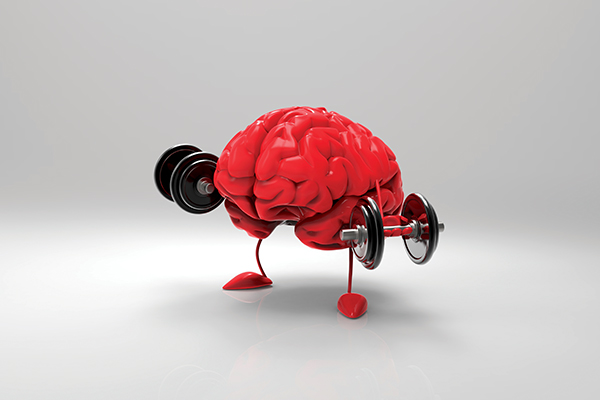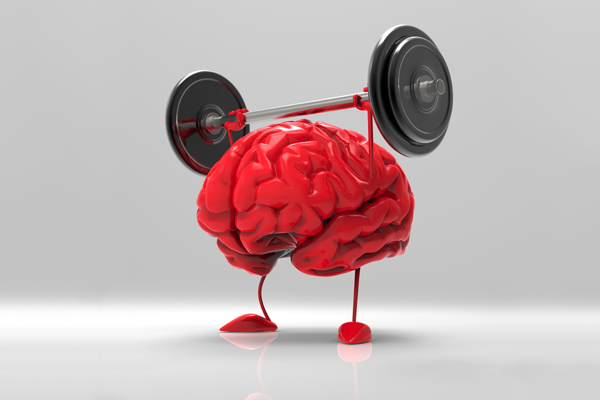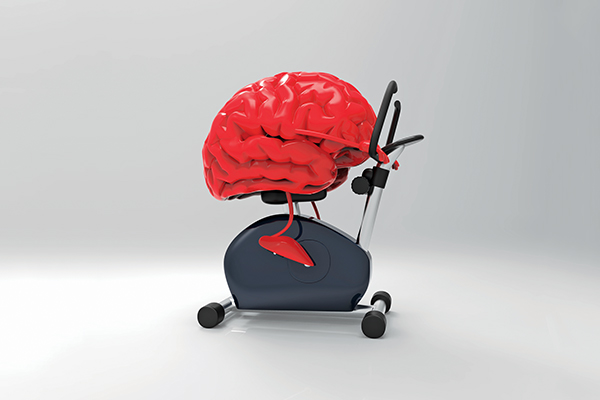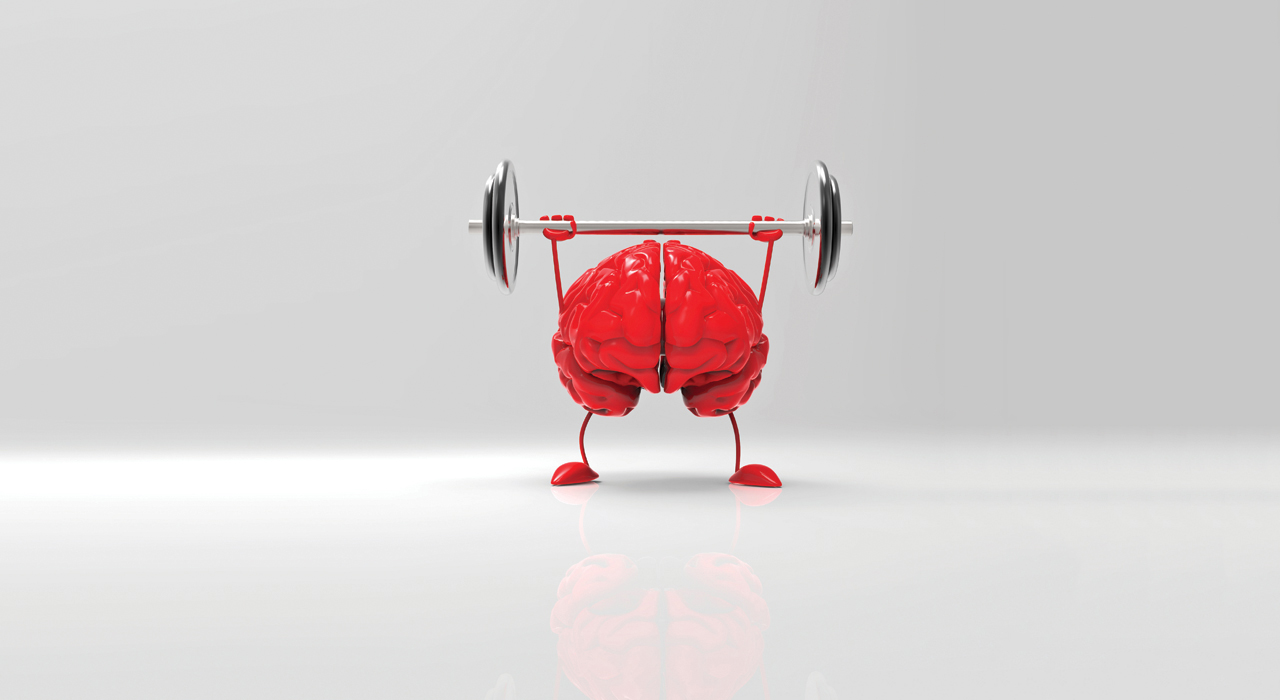You’ve heard that success is all in the mind, or probably heard the quip, “mind over muscle” but it’s more true than you might think. Use the latest science to harness the perfect blend of grit and calm to upgrade your performance almost instantly
Words: 2500 words (around 20 minutes reading time)
Author : Dan Hardman
How does your mind affect your muscle?
Think about your last burst of serious physical effort: a spanking new PB in the gym, an all out effort on the rower, or the last few miles of a marathon. If you were going for it – really going for it – there was a point where you didn’t just want to give up, but you felt like you had to. Yet, somehow, you pushed through and found a way to lift the weight one more time, sprint those last hundred meters, or slave drive your protesting legs to keep trucking, despite them pleading for a rest.
Until recently, scientists would have suggested that what got you through these feats was your physical preparation: your V02 max, fast-twitch fibers or your lactate threshold. Now, an ever-increasing body of evidence suggests that what stops you every time is, in fact your mind, not your body, and that working on the mental aspects of performance might just be the best thing you can do for your brain and athleticism.
Is mind over muscle legit or hocus-pocus?
Mental coaching for sport has been around for a long time, but it’s traditionally one of the least-understood elements of training, focused on things like visualization, relaxation and the power of positive thinking – imagining scoring the perfect touchdown or running the perfect race – with little ability to extend the body’s hard physical limits. In the late 1990s, for instance, the popular perception of how the brain limited the body was based on Professor Tim Noakes’s Central Governor Model (CGM).
The CGM suggests endurance performance in particular is limited by a subconscious system in the brain so the body never exceeds its limits: regulating muscle recruitment to avoid heat shock or heart problems.
Over the last few years, though, a new way of looking at things has developed called the Psychobiological Model that’s backed up by dozens of studies and promises to turn brain power into real world power. According to this version of events, perceived effort (PE) is crucial; exhaustion happens not when your body hits a hard physical limit, but when you hit the highest PE you’re prepared to tolerate. Your body isn’t shutting down: you’re consciously deciding when to quit.
Train your brain for the final straight
Obviously, this theory has its critics because it’s not practical to think that every time you end a workout with anything less than a stellar personal best, you’re essentially quitting. However, the science seems to back it up.
In one test conducted by Samuele Marcora, the primary developer of the Psychobiological Model, 10 volunteers from Bangor University rugby team were asked to pedal exercise bikes at a fixed wattage for as long as they could, stopping only when they couldn’t complete another single pedal stroke at that level of effort. Then, the nasty bit: as soon as they gave up, they were told to pedal for five more seconds, this time going all out.
The results were conclusive: in the fixed-wattage effort, the athletes managed an average output of 242 watts for around 12 minutes each, but in the final blast they cranked out 731 – more than three times the effort level they’d been unable to sustain a moment before. The only reasonable explanation was that, in the extended effort, they gave up, these well-trained athletes, used to pushing themselves, couldn’t tolerate the open-ended suffering any more and had to stop. Then, when they were asked to give it one last push, they found new reserves of energy that they didn’t even know they had previously, because you can do almost anything for five seconds.
According to Marcora, fatigue in endurance exercise is always voluntary: glycogen depletion and lactate build up happen, but their key effect is to force the brain to work harder and harder until pushing through the pain no longer seems worth it.
Backing this theory up, even tiring out the brain in advance makes physical exercise harder. In another study published in the Journal of Applied Physiology, Marcora pre-fatigued subjects’ brains with a mental task done before an endurance test, causing them to report higher perceived effort and hit the wall faster than they did when doing the same test without the mental task. Your brain is in firmly charge, not your body. So what should you be thinking about while you’re sweating it out?

Using your muscle and mind to win
The answer, according to anecdotal evidence from thousands of athletes, seems to be: it depends what kind of person you are. “Mental fitness,” writes Matt Fitzgerald, author of How Bad Do You Want It? “…Is a collection of coping skills, behaviors, thoughts and emotions that help athletes master the discomfort and stress of the athletic experience, mainly by increasing tolerance for perceived effort and by reducing the amount of effort that is perceived at any given intensity of exercise.”
Exactly what these coping traits are, and how effective they’ll be, varies hugely, but there are a few constants.
“If you believe that you cannot improve as an endurance athlete except by changing your relationship to perceived effort, you will be more successful in doing so. If you buy into the idea that you should be your own sports psychologist, and that your objective in this capacity is to engage the full power of your mind to increase the amount of effort you are able to give and to enhance what you get out of your best effort, you will build mental fitness more quickly.”
Brace yourself – the pain is coming
The strategy that most directly contradicts traditional sports psychology, for instance, is bracing. During visualization training, athletes are often told to imagine the perfect race: everything going to plan, with victory coming easily.
The problem, according to research, is when athletes end up feeling worse than they ‘expected’ during a race; they start to develop a bad attitude about their discomfort and end up slowing down more than they need to.
You might have noticed this if you’ve ever tried rowing or running 5k in a set time – 20 minutes, say. If you tell yourself that it’s going to be easy then, as soon as the discomfort starts, the negative self-talk sets in. If it feels hard after a thousand metres, how can you possibly do another four at the same pace?
‘Brace’ yourself for the unpleasantness, though, and things get much easier. Accepting that it’s going to hurt makes you feel more positive about the pain without actually easing the pain at all. Relatedly, further research suggest that how much effort you can put in to reaching a goal depends on how attainable it seems. If it seems impossible, you’re likely to back off, but if it seems manageable with just a tiny bit of increased suffering, you’ll go for it.
In a study from Israel’s Ben-Gurion university published in the Journal of Sports Science, for instance, some students were just told to ‘do their best’ in a test of muscular endurance, while others were given a percentage target to aim at. After eight weeks, the students who were given explicit goals did better, but the students given a ‘difficult/realistic’ goal improved more than the ones given easy or unattainable targets. The lesson? If you’re aiming for a new bench press PB in eight weeks, make it hard, but realistic; it’s better to aim for a small increase and get after it with everything you’ve got than shoot for an additional heavy plate on each side and fail miserably. Building confidence is a game you need to do.

Release some pressure – use your mind to relax
Then again, it’s not always ideal to give your full attention to the pressure to perform that you may be under when you’re at an event and want to exercise at your best.
According to recent research into the workings of the brain, it’s not ‘pressure’ that causes athletes to underperform in difficult circumstances, but self-consciousness and getting distracted from actually performing by thinking about the consequences of success or failure.
“Racing in a state of pressure-induced self-consciousness is like fire walking while giving your full attention to the painful heat in your feet rather than focusing on where you’re going,” says Fitzgerald. “As an athlete, you’re much better off directing your attention externally, to the task at hand, which distracts you to some degree from your suffering, allowing you to push a little harder.”
Different athletes have different ways of doing this: focusing on the crowds, the competition, or just trying to perform to the best of their ability, without worrying too much about the overall results.
There’s evidence meditation can help: a 2011 study in the journal Psychiatry Research: Neuroimaging showed doing it for 30 minutes daily for eight weeks ‘rewired’ grey matter to alleviate stress and enhance focus and concentration. If you want to take it a step further you can try a new option called neurosculpting.
Lisa Wimberger, who runs The Neurosculpting Institute in Denver, goes a step further, by attempting to create new ‘automatic’ processes in your brain so when something stressful happens, her athletes react calmly instead of going into fight-or-flight mode. Wimburger’s lessons involve thinking about stressful situations and then giving them a physical representation – a color, texture or sound – and visualizing them ‘leaving’ the body. Thinking in this way, Wimburger claims, involves both hemispheres of the brain, increasing its neuroplasticity and your ability to create new thought processes.
It’ll help you adjust to that snapped shoelace at the starters line or that dead weight feeling when you’re squatting your maximum. Possessing the ability to overcome the less-than-perfect outcomes during a lift or event is what can help you get the most out of your performance and body.
Increase your inner zen to win
Then there’s mindfulness. The term comes with a bit of baggage; it’s more traditionally associated with flax seed-loving Instagrammers than elite athletes, but that’s slowly changing thanks to teachers like Mindful Athlete author George Mumford, who spent years teaching prison inmates to shift the behavior-triggers that sent them into violent meltdowns before he was offered a job working with the Chicago Bulls basketball team.
Mumford spent five years working with the Bulls as they won three championships, turning star player Kobe Bryant into an outspoken fan of meditation. He’s understandably reluctant to lay bare all of his methods, but he focuses on helping his athletes dealing with the distractions of high-level competition, from ticket requests to the pressure of big-game performance.
When Mumford started his work in 1993, Zen coaches on the sidelines were a very rare sight; now, behavioral health and meditation sessions in pro teams are more common than jock itch. Users of these techniques don’t train any easier, but do learn to live in the moment, looking to perform their best rather than do anything outside their control.
Psychologists call this ‘adaptive perfectionism’ – a never-satisfied mindset that can have a positive impact on performance without leading to compounding problems further down the line. It’s about working hard, but also learning to trust your intuitions.
Mind over muscle to become bigger, stronger and faster in life
There’s also a flip side to all this hard work. The coping skills you build in the gym, on the road, or on woodland trails at 6am on a Sunday morning also help you cope better in real life. There’s evidence, for instance, that the anterior cingulate cortex (or ACC), is strengthened by certain traumatic experiences, making endurance athletes less likely to give in to the urge to slow down when their legs start screaming. But endurance exercise also strengthens the ACC itself, leading some researchers to speculate that pushing yourself harder in races makes you better able to cope with real-life adversity.
Robert Wicks, a psychologist and author, calls the anger that many athletes draw on in races ‘Sweet disgust’, to convey the state of mind where motivation goes up from a determination to fight back against perceived unfairness or inadequacy. Of course, mindfulness helps, too. By learning to try your best in competition (with yourself or other people) without getting too invested in the results, you’re building mindfulness skills that work in the office or relationships.
Really, this is one of the best reasons to exercise: by running hard, lifting heavy, or pushing yourself in the WOD until you’re on the verge of collapse, you aren’t just increasing your capacity to do it again, you’re improving your ability to do everything else at a higher standard. Isn’t that better than a 5k PB?

How performance starts in the mind for…
For better CrossFit times, take responsibility
Still hoping double-unders don’t come up in the CrossFit Open? You’re lacking what sports psychologists call ‘resilience’ – if you’re too psychologically dependent on things going your way, you’ll end up nervous and over-emotional.
Take a tip from Rich Froning and focus in on weaknesses (like rope-climbing) to make them into strength. By taking total responsibility for your own performance, you’ll develop a sense of control that calms you in competition.
For a 5k PB… Use positive self-talk
In a 2014 study that appeared in Medicine and Science in Sports and Exercise, a team of scientists led by Samuele Marcora invited volunteers to pedal stationary bikes to exhaustion at high intensity in two tests. Between sessions, half of the subjects were trained in positive self-talk – the others weren’t. When the endurance test was repeated, the subjects trained in positive self-talk improved their time to exhaustion by 17%.
For a three-hour marathon… Get encouragement
In a 2002 study from the Journal of Sports Science, subjects doing V02 max tests on a treadmill finished with higher blood-lactate levels when they were encouraged every 20 seconds than when they were shouted at less frequently, or watched in silence.
The implication: high expectations made them try harder, so they got closer to their ‘true’ physical limit. If you’re running a marathon, put your name on your shirt. Every bit of encouragement helps.
For better body composition… Stop fantasizing about success
According to more than one study, the more time you spend fantasizing about the outcome you’re hoping for – imagining what it’ll be like to have the perfect body, for instance – the less effort you’ll put into making it happen.
Psychologists speculate that excessive fantasising can actually decrease your confidence about your ability to make your goals happen. Instead, focus on concrete steps, like habit change or setting up your life to make good decision-making easier.
For a bench-press PB… Get stronger friends
In a 2009 study from Oxford University, rowers who worked alongside other athletes as a group were less sensitive to pain after rowing as a group, something the researchers put down to greater endorphin release in the brain. An effect known as ‘behaviorial sychrony’ also kicks in when you train in groups, making you more likely to elevate your performance to the level of the people you hang around. If you’re the strongest person in your gym, find a new gym. If you have no training buddies, get fitness coaching.
For five-a-side soccer dominance… Use ‘bulletin boarding’
“Athletes in team sports often talk about bulletin board material,” says Matt Fitzgerald. “Insults, taunts, challenges and disrespectful words from other teams, posted in the locker room – often with good results.” Anger can pay dividends; in a study reported in the journal Psychological Science, it greatly improved performance in a hand-grip strength test. Use that trash talk to your sporting advantage.
References
http://www.psyn-journal.com/article/S0925-4927(10)00288-X/abstract







